Henry VIII (1491-1547), King of England
King of England 1509-1547, of the Tudor house, son of Henry VII and Elizabeth of York. A papal dispensation was secured in 1503 to allow the betrothal of Henry to his brother Arthur's widow, Catherine of Aragon. Six years later he succeeded his father to the throne and married Catherine.
Henry VIII. exhibited a fondness for sport, hunting and military.

Henry VIII.
Says (paraphrased) Carrolly Erickson, in Royal Panoply
Prince Henry at sixteen, was kept in strict isolation.. bodyguards and a restricted circle of carefully chosen companions. Recreation confined to a private park, jousting partners limited to those the king trusted. Henry, the only surviving son, his older brother Arthur dying five years earlier. Also subjected to his ill father's furious fits of rage, during which the king became so angry that he fought with the prince, as violently "as if he sought to kill him," observers thought, never knowing when these onslaughts might come, or whether, in his unbalanced state of mind, might resort to even harsher punishments, banishment or imprisonment. In April 1509, he was summoned to his dying father, among his last wishes was that Henry should marry the his brother Arthur's widow, Catherine of Aragon. Two months following the death of his father, Henry did so, against advice of some churchmen and courtiers, for such a marriage under church law was condemned as "an impurity". In the biblical book of Leviticus, it is written that God would punish with childlessness those who made such a marriage. However, the Pope made a special dispensation permitting Henry and Catharine to marry.
Student of the Renaissance, he entertained at his court the disciples and teachers of new learning. Henry was devoutly religious, writing a treatise against Luther, Assertio Septem Sacramentorum and in 1521 given title by Pope Leo X in Rome, "Defender of the Faith", Fidei Defensor.
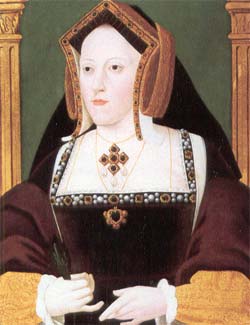
Catherine of Aragon, First Wife of Henry VIII.
In 1513, Henry personally led English forces in a campaign against Northern France. King James IV of Scotland invaded England but was defeated and killed at Flodden Field by the English. Deserted by allies in 1514, In order to form an alliance, Henry married his sister Mary to King Louis XII of France, subsequently appointing Thomas Wolsey, the archbishop of York as lord chancellor, commissioning him as director of foreign policy.
In 1519, Charles I of Spain made accession to the throne of the Holy Roman Empire, and hostilities between King Francis I and Charles became inevitable. Henry sided with the nephew of his wife, Charles, in the war of 1521. England took part in the campaigns of 1522 and 1523. In 1525, riots erupted in England in protest of attempts by Henry to raise monies for military purposes, thus halting England's full participation in the war.
In 1527, for Catharine's failure to bear a male heir, Henry desired to divorce his wife on grounds the papal dispensation which made the marriage possible, was invalid.

Anne Boleyn, Second Wife of Henry VIII.
Says (paraphrased) Carrolly Erickson, in Royal Panoply
In the 1520's, Henry seems to have convinced himself that his lack of a son was a divine punishment for his having married his brother's widow. Despite papal dispensation, despite insistence that she and Henry's brother Arthur had never consummated their marriage (and therefore she was not truly Arthur's widow), Henry believed that he and Catharine had sinned; they were being punished.
Catharine's only surviving child was a girl named Mary. Chance of succession to the throne in England was doubtful as no woman had ever successfully ruled the throne. (One expirament with a Queen regnant when Henry I left his kingdom to his daughter Matilda in the twelth century, had resulted in civil war and Matilda never crowned.
Royal Panoply, p. 169, Henry VIII.
Henry had fallen in love with Anne Boleyn, a young and beautiful lady-in-waiting of the queen. However, Pope Clement VII, could not invalidate the marriage without displeasure of Charles V., thus Wolsey and Lorenzo Campeggio, papal legate were appointed to try the case in an English legatine court. Eventually the case was summoned to Rome. The prospect seemed hopeless to secure papal annulment. Wolsey was dismissed, appointing Thomas Cromwell chief advisor, and making Thomas More lord chancellor. Both men favored reform within the Church.
Henry proceeded to dissolve relations binding the Church of England with Rome. Through aid of Parliament and legislation, Henry secured for himself control over clergy, and in 1532 compelling them to acknowledge the throne as head of the church in England. Any new canons would need to be submitted personally through himself, for approval.
Says (paraphrased) Carrolly Erickson, in Royal Panoply
Henry decided to divorce Catharine and marry Anne, presuming the matter would be resolved in a matter of months. Rulers often discarded their spouses, usually by technicality of canon law; accommodating popes granting dissolutions or other legal arrangements. But upon his appeal to Rome, he confronted delays. Queen Catherine, by means of her powerful nephew, Holy Roman Emperor Charles V, showed herself to be a formidable adversary. The divorce suit dragged on for years. His divorce had became a cause known throughout Europe, provoking Charles V to threaten war. All Catholic powers stood against England, and Henry, seeking allies, turned to the followers of Martin Luther. When Henry learned that even Luther supported Queen Catherine, he suffered as never before, from insomnia, headaches and desperation.
In 1532, Anne consented to become Henry's mistress and became pregnant. Henry ignored the advice of councilors, declared his marriage with Catherine dissolved and secretly married Anne, then publicly had her crowned. However, hope of a male heir turned to dismay when Anne gave birth to a daughter, Elizabeth, in September 1533.
Henry's devoted archbishop Thomas Cranmer of Canterbury, declared the union with Catharine of Aragon void and the marriage to Anne valid. An act of succession by the archbishop affirmed Anne's progeny as royal heirs.
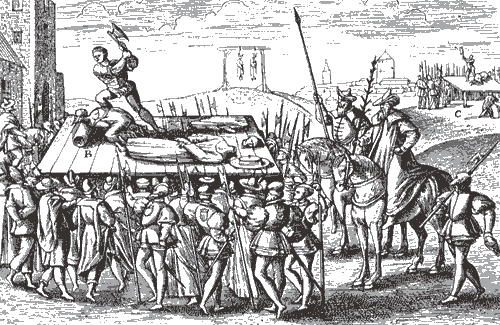
Bishop John Fisher and Thomas More, publicly beheaded in 1535.
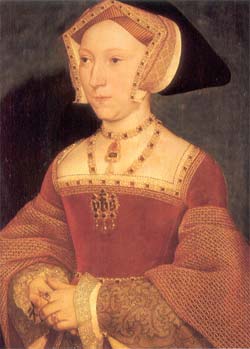
Jane Seymour, The Third Wife of Henry VIII. who gave birth to Edward.
In 1534, Pope Clement VII refused sanction of the divorce, ex-communicating Henry and by act of supremacy, Henry repudiated the Pope's jurisdiction. Declared the supreme ecclesiastical authority of England, an oath was thus required of English citizens in 1533 and 1534. Thomas More and St. John Fisher were among those executed for refusal to accept the King's supreme authority over the church, though willing to accept Anne's children the rite to royal succession.
In 1536, the King dissolved lesser monastic communities and by 1539 abolished all remaining monasteries, despite the occurrence of uprisings against the action, the Pilmagrage of Grace. Monastic properties were sold or given to noblemen in exchange for support.
Although the character of the English church was altered, Henry had no desire for protestant reform in the church. Those citizens refusing to accept Catholic teachings, or those who rejected Henry's ecclesiastical authority, were executed.
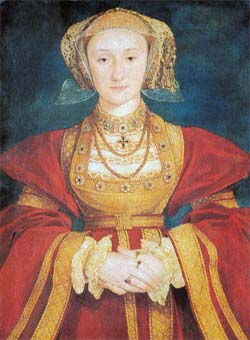
Anne of Cleves, The Fourth Wife of Henry VIII.
In 1536, Henry issued a creed which generally adhered to the Old order of things, known as the Ten Articles. In 1539 he published the Six Articles, providing reaffirmation of the Catholic view. The only significant changes to Orthodox religion during Henry's reign were the licence of an English Bible, issuance of Cranmer's litany and translation into English, certain portions of the traditional service.
Henry had acquired more wives, charging Anne Boleyn with incest and adultery, who was executed by beheading, in 1536. Following her execution, Henry married Jane Seymour who died giving birth to Edward, the only son of Henry. In 1540, another marriage with Anne of Cleves to form ties with Germany's Protestant Princes. This marriage was soon dissolved on ground she was ugly, then marrying Catherine Howard in the same year, who was executed on ground of adultery and being unchaste prior to marriage. The following year, Henry took his sixth wife Catherine Parr.
Says (paraphrased) Carrolly Erickson, in Royal Panoply
In his forties King Henry, always confident developed unshakable inner certitude. He ceased to listen to any advice and relied on no one but himself, trusting his own opinions completely. To symbolize this transformation, he wore a gold bracelet inscribed, in French, "plys tot morir que changer ma pens?e," that is to say, "to die rather than change my mind." Henry's behavior became bewildering, filled with contradiction and increasingly inclined to caprice. He was erratic in his behavior, argumentative, contrary and combative. King Francis I remarked him to be, "the strangest man in the world". Spies searched out disloyal subjects and Bishop Fisher and Thomas More, once beloved friends were put to death, followed with Anne, whom after miscarrying a male child, too was beheaded along with a number of alleged lovers.

Catherine Howard, Fifth Wife of Henry VIII.
However, where Anne had failed to give the king a male heir, Jane Seymour succeeded, giving birth to Prince Edward.
After Jane Seymour's death, Henry swore that he should never remarry. But within a few years he changed his mind and chose a Protestant bride, the sister of the Duke of Cleves. To his everlasting regret, he agreed to marry Anne without ever meeting her, relying on portraits and reports of envoys sent to Cleves. Though Anne was neither ugly nor objectionable in any obvious way, Henry found her physically abhorrent. On first seeing her, he was "marvelously astonished and abashed," overwhelmed by his "discontentment and misliking of her person." Though overwhelmed with misgivings, he married her only to discover that he could not bear to consummate the marriage. Within six months he had it annulled, though the king felt no animosity toward his fourth wife and she continued to live contentedly in England after the annulment.
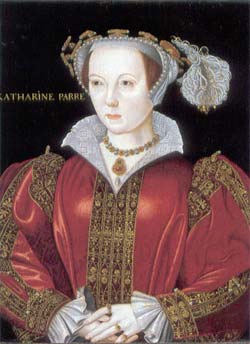
Catherine Parr, Sixth Wife of Henry VIII.
Following ridding himself of Anne of Cleves, Henry took to himself another wife, young Catharine Howard. Henry was 49 years of age, and presumably Catherine in her teens. The king doted on the young girl, "caressing her more than he did the others," as the imperial ambassador noted. Catherine was his thornless rose, the rejuvenating comfort in his old age, at last, a woman who satisfied his desires and need for long-term companionship.
When Henry learned Catherine had been unfaithful to him, he called for a sword to have her killed. He mumbled, "that wicked woman had never such delight in her incontinency as she should have torture in her death."
He wept publicly over his ill fortune, declaring he would never marry again. But those who saw him feasting and celebrating on the day of Catherine's condemnation had no doubt that he was once again searching for a wife, and in 1543 he found one in Catharine Parr, a mature, educated, good-natured widow of thirty-one. Catherine remained by the side of Henry until his death.
Henry was involved in war with Scotland and France between 1542 and 1546, defeating the Scots at Solway Moss, later conquering Edinburgh. Boulogne was captured in 1544, and in 1546 when peace was made, Henry received French indemnity. At the end of Henry's reign he was considered gross, egotistical and despotic. Much of the wealth obtained by the sale and distribution of Monastic property was wasted upon revelry. However, he retained loyalty of his subjects. Under Henry, England prospered material-wise, and citizens receiving equitable treatment in legal issues. Henry was also fond of naval growth, thus known as the father of the English navy.
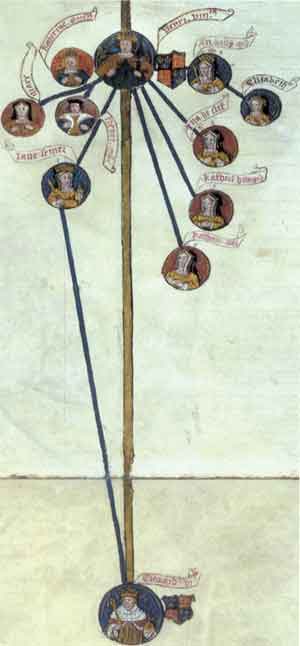
King Henry VIII's royal line. Edward VI., his son is joined to the King by a thick line, while the wives and other offspring are joined with thin lines.
References
- Funk and Wagnalls Encyclopedia, ©1950
- Royal Panoply, Carrolly Erickson, History Book Club ©2003


No comments:
Post a Comment